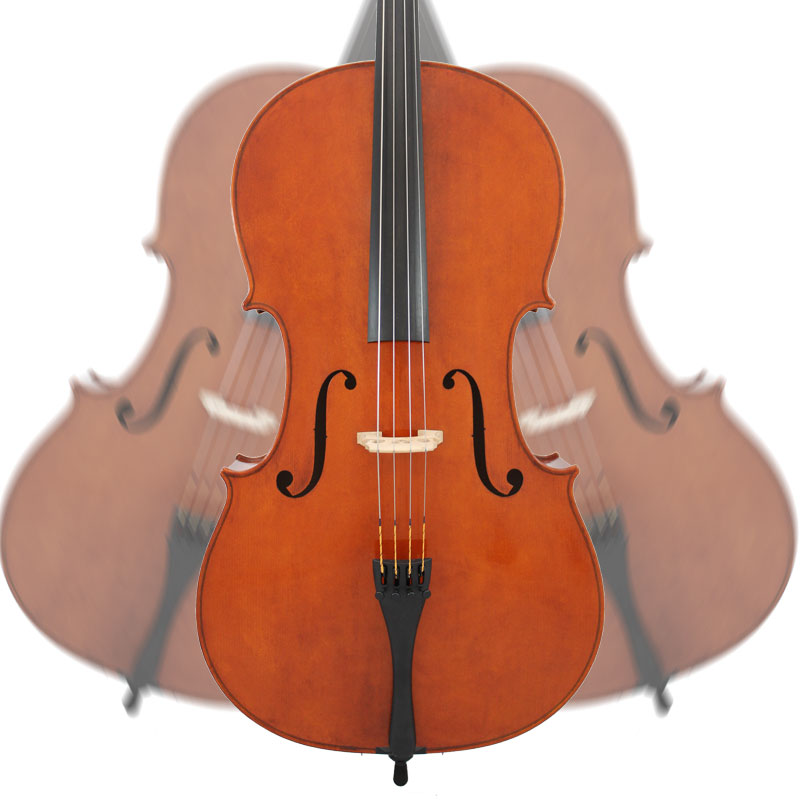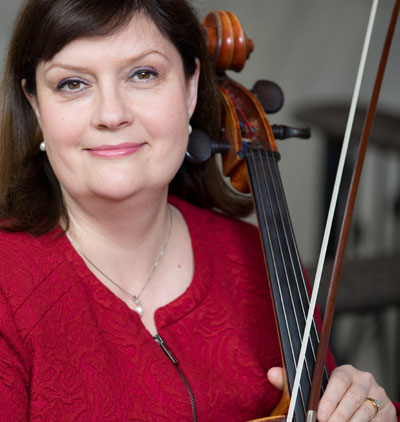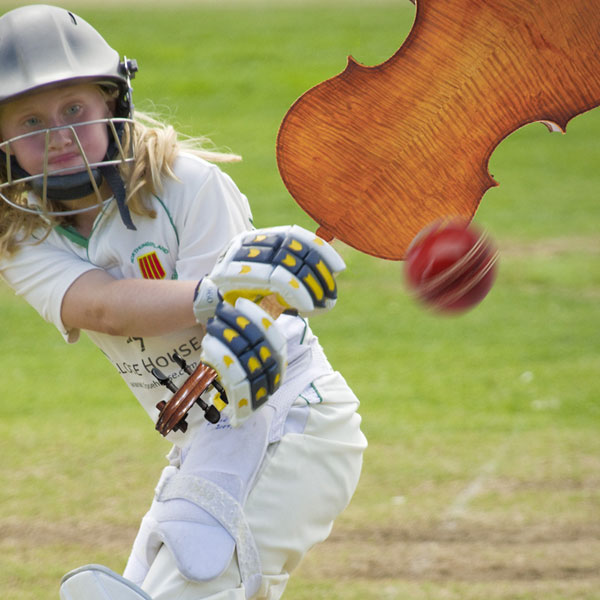Katri Patel’s Blog
Cello Teacher. A Teacher’s Notes
‘…music affects us in so many ways. It creates lovely memories that stay with us, it improves our mood, helps with concentration and even affects our intelligence. In fact it is so good for us that it really should be prescribed by doctors!’

We couldn't do it without you...
Our thanks go to Katri not only for this video but for her kind assistance in the development process of our fractional cello strings.
Katri Patel was born in Kuopio, Finland and started playing the cello at the age of 8. She attended a summer music course near her home town in Finland and had her first cello lessons with Csaba Szilvay.
Katri went on to study at the Sibelius Academy in Helsinki from where she graduated with a Master’s degree and a Cello Diploma in 1996. Since then, she has played with many orchestras both in Finland and in the UK including the Finnish Radio Symphony Orchestra, the Royal Scottish National Orchestra, the London Philharmonic Orchestra, the Royal Philharmonic Orchestra and the Britten Sinfonia.
We are delighted to welcome Katri Patel as a contributor to Larsen Strings.
Katri’s Blog
Cello teaching at a time of Corona
I am writing this in the middle of May when many countries are slowly returning to some kind of normality. Here in London we are still asked to stay at home, avoid public transport and only go out for exercise or essential shopping.
My working life changed dramatically 8 weeks ago when the music centre where I teach closed doors and lessons were moved online. It has been truly challenging to move 18th century teaching methods to the modern day but I am aware how fortunate I am. Many musicians around me have lost all their income and are in a financially very difficult situation. I am lucky that I have been able to keep working all this time.

We had some warning about the closure of the premises and starting the online lessons. I wasn’t that worried, I assumed it would be quite simple, something like a Skype or FaceTime call. Ah, how wrong I was! It wasn’t simple at all and the first lessons were a real shock. The sound was just terrible, one of my colleagues aptly described it like her pupils would be playing the cello under water! The picture kept freezing, the parents were really stressed out, everyone’s cellos had gone massively out of tune just that week, I had to lip read when my smaller pupils spoke and the worst of all, when I tried to help them tune their cellos, every time they played the open C string the sound went completely mute!
Well, after 8 weeks things have improved a little bit and I even have discovered the reason for the muted C string. It has been exhausting but very educational as well. They say that old dogs don’t learn new tricks but even though I would class myself as technologically challenged I have had to learn to use Zoom, Skype, FaceTime, GarageBand, Dropbox – many of which I hadn’t even heard of few months ago.
And it’s oddly satisfying to realise that I am not the only one who struggles with all these new things. The parents of my pupils are often much younger than I but many of them are equally lost and stressed out in this new virtual world.
My employer had sent the families very detailed emails about online safety, Zoom and Skype settings, ideal camera angles, tuning the instruments, room settings, lighting, improving internet connections, preparing for the lessons etc. I quickly realised that hardly anyone had read them. On first few lessons I had some pupils placed in front of the window on a bright and sunny day resulting the pupil looking very dark against a blinding light behind them. Or in some cases I could see just their face. As lovely as their little faces are, I do prefer to see their bow hold, left hand and even how they sit.
There were also some bizarre camera angles, noisy siblings and sometimes the pupils were not on time as someone else had needed the laptop or tablet for work conference call or another lesson.
In the defence of the parents I have to say that they had been placed suddenly under enormous pressure. Practically overnight they became the home educators of their children responsible for their schooling. Their own jobs became remote where possible but many also were laid off or furloughed and on top of that their children’s many hobbies keep sending numerous emails and then the cello teacher enthusiastically bombards them with links to excellent online concerts, cellists’ social media pages (Gautier Capuçon’s daily lock down music sessions and weekly home concerts being a great favourite) and musical activity pages… No wonder many of them look exhausted.
I have realised that even if my pupils are not progressing much during the lockdown , my main job during this worrying time is to provide some sort of normality and stability to the children’s lives. They are missing friends, school, grandparents, playing outside and their normal activities. And whether they admit or not, many are also very scared of what is happening around them.
‘If I can be the constant in their changing lives appearing online every week same time asking them to play the scales, arpeggios, exercises, and hopefully some fun pieces, then I am happy, even if they do sound a bit like dolphins.’
Little by little we have managed to solve many issues we had with the connections and sound. All the platforms used for the online teaching have been designed for speech and they have inbuilt features to reduce background noise. Oddly they all consider cellos to be background noise and do their best to suppress the sound. That’s is the reason for the muted C strings. Fortunately there are some settings that can be changed to improve the sound. For example Zoom has a very confusingly named “enable original sound” setting that has to be turned on for it to allow background noise (cello playing!)
The best by far to deal with the online technology are the youngest of my pupils. I have 5 year old pupils who managed to send me thumbs up-emojis during their first Zoom lessons (I didn’t even know that there was such a feature on Zoom) or they can easily turn on virtual backgrounds.

Modern technology can be hugely helpful. I have been so glad that we can easily download tuning apps for mobile phones, practically in minutes. The chromatic tuners that show visually whether the string is too low or too high have been a huge help for many inexperienced parents during the lock down. With the help of these apps most of my pupils now have their cellos tuned before their lessons.
I have also discovered how to scan pages of music with my mobile phone which makes it easy for me to email various extra exercises to my pupils.
Despite the initial shock and many problems, I have learned a lot and I have had a glimpse of the home lives of my pupils. I have met some parents I hadn’t yet seen, I have seen what kind of chairs my pupils use at home ( very important for cellists) , I have been introduced to a very reluctant and shy hamster and a dog who is simply desperately keen to appear on every single cello lesson. I suspect he loves the cello…
I hope that we all can return little by little to our normal jobs. I look forward to a day when concerts can be held again and when I can be in the same room with my pupils guiding the bows or moulding their hands. After all, nothing beats the age old methods of face to face teaching. Until we meet again….

Katri’s Blog
Wobbling Cellos and Falling in Love with Shostakovich
A little over a year ago, I wrote a blog about my new year promise to attend more concerts and also, more importantly, try to encourage my young pupils to experience the wonderful world of live music. I would like to share some of my experiences and some of my pupils sometimes funny, sometimes uplifting stories of the concerts they attended.
There is something extraordinary about a live performance, a special kind of excitement in the air, the common sharing of listening with other people, feeling the vibrations of the instruments and of course the visual experience -they all add to the occasion. In our modern times it’s rare to have moments when the phones are turned off so that there is nothing to tempt our attention elsewhere than listening to music and letting it take us and our thoughts on a journey.
During the past year and half I have heard some truly wonderful concerts. I have been to the Covent Garden opera, I have heard vocal ensembles, orchestras, spectacular violin playing, superb Brahms piano trios performed by Leonidas Kavakos, Yo-Yo Ma and Emmanuel Ax as well as many great cellists.
I visited the Savonlinna Opera Festival where operas are performed in the courtyard of a medieval castle and saw a fantastic production of Gounod’s Faust. I was surprised to discover the beautiful Cello Sonata by James MacMillan dedicated to Raphael Wallfisch which he performed with John York in their duo anniversary concert. It was a reminder that there is always something new to discover even for an experienced audience member.
I listened to exhilarating virtuoso playing by Alban Gerhardt in a concert that on top of the musical offerings, also gave an opportunity to truly appreciate the wonderful instruments the top players have. In the middle of the Rococo Variations Mr Gerhardt broke his C string and instead of going to the back stage to change the string he borrowed a cello from the principal cellist of the orchestra and continued. As wonderful as his playing was it clearly demonstrated why the rare, old Italian instruments, can cost fortunes. The cello he borrowed was a fine instrument but no match to his superb sounding Goffriller.
I was also lucky to hear Gautier Capuçon play all those beautiful cello pieces that we often hear as encores including a wonderfully gentle rendition of the Meditation Thais. The beauty of his playing made me so happy that I smiled all the way home despite the odd looks from my fellow passengers on the London Underground (not usually a place that makes anyone smile)
We were very fortunate to have a great year long festival dedicated to cello called Cello Unwrapped at the Kings Place. At the opening concert I spotted one of my young pupils sitting behind the stage with a great vantage point to observe the Soloist and the orchestra’s cello section. I was hoping that he would notice the relaxed shoulders, supple bow holds, smooth position changes etc. But instead he told me during the interval that he had counted how many strings the harp has! A small disappointment but I later found out that kids do notice many things even when they appear distracted.
On his next lesson his cello was wobbling oddly. I asked him to keep his cello snuggly between his knees to stop the cello moving. He then asked me that hadn’t I seen how Mr Gerhardt had been swaying with his cello? I pointed out that Mr Gerhardt swayed ‘with’ his cello instead of just the cello moving. We then practiced swaying with the cello whilst playing the scales. In the end my pupil (aged 9) told me that maybe Mr Gerhardt plays so brilliantly because he had done his home practice very well, not because of the swaying…
This particular boy became very concerned about the condition of his strings after witnessing the quite dramatic breaking of the C string. He was so worried about it happening to him that I explained how very rare thing it was and was not likely to witness it again. The next concert he attended was a recital by the very talented young cellist Sheku Kanneh- Mason. Unbelievably Mr Kanneh- Mason also broke his C string. My young student now believes he is doomed…
I try to encourage all my students to attend as many concerts as possible but it’s especially important for the beginners to hear cello being played at the highest level to keep them interested in the instrument whilst playing very simple tunes themselves.
One young beginner came to her lesson bursting with excitement wanting to tell me about a wonderful concert she had been the night before. I must admit feeling good about recommending the cello festival but it wasn’t quite what I was expecting. She told me she had seen this amazing cellist playing standing up! Not only that but this virtuoso performer had also managed to play the piano with his bottom whilst playing the cello standing up!
For a moment I was worried that she might now want to play the cello standing up but fortunately she reassured me that she had decided to master the cello in the seated position first…
Of course every concert isn’t as memorable or exciting as the previous example.
One mother complained that her son always falls asleep at concerts. He had managed to sleep through the complete Bachianas Brasileiras for soprano and 12 cellos. Fortunately she persisted in taking her sleepy son to many fine concerts as eventually a concert was so exciting that he not only stayed awake but fell in love with Shostakovich. It has had an amazing effect on his playing, the previously slightly careless young man who didn’t show much interest in cello or music in general, is now a changed person with great love for music and good progress with his cello playing.
I would like to encourage all parents to keep taking their children to concerts even if they first seem disinterested. Of course it’s important to choose concerts that are well suited for their age and experience level. Most children would struggle with the complete string quartets by Penderecki or Wolf’s Lieder. But they might love to hear Vivaldi, Mozart, Saint-Saens or the more rhythmic music by Shostakovich, Prokofiev or Stravinsky.
The Larsen Strings uses the slogan: “We couldn’t do it without you” pointing out the importance of the professional players’ feedback for the continuous product development. The same slogan could also be used to remind the importance of the audience for even the greatest musicians. They need us and we need them.
Katri’s Blog
Music and Memory
Music and memory – those two words bring so many associations to mind. We might think about our musical memories – fantastic concerts we have heard, first piano lessons, singing Christmas carols with our family etc. For me those two words bring to mind something else, firstly how music affects our memory and secondly my cello pupils’ struggles with memorising music.
My father suffered from very advanced Alzheimer’s. The cruel condition had robbed him firstly of his short term memory and later most of his earlier memories as well.

But in his last few years he surprised us by starting to sing. This was something he had never done before, in fact he had always joked how lousy singer he was. But we discovered that he was in fact a very good singer but more surprisingly he could remember a huge number of songs by heart. He sung folk songs, hymns, children’s songs, Christmas carols. The kind of songs he would have known when he was young. In total he could remember well over 50 songs and often several verses of each song.
We were amazed that how is it possible that a man who has practically no memory left can remember the songs with ease. I later discovered that my dad was not alone. Many Alzheimer’s patients and dementia sufferers have the same ability. Even people who have lost the ability to speak many years ago can suddenly start singing if someone sings to them. Music lives somewhere so deep within us that when everything else disappears, music still remains and brings us joy.
My young cello pupils are sometimes very reluctant to learn anything by memory. I try to convince them that they will only know the piece, scale or an exercise truly well if they can memorise it. Playing without the sheet music also frees the mind to concentrate on musical phrasing or technique. Of course it also has the added bonus that I as a teacher will then know that they have actually practised at home rather than desperately trying to sight read in front of me, which unfortunately does happen quite often.
But I also believe it is good for them. I recently read a brilliant article by a leading Finnish child psychologist, Professor Liisa Kelttikangas-Järvinen. She reminds the readers about the importance of using our memory and of the importance of children needing to do the same for the benefit of their development. She is less impressed by some recent educational trends which turn away from memorising things to finding the information online. In the article she points out that to memorise something a child will develop memory rules and seek logic to support the memory. The ability to do this creates intelligence. What more can I say to any doubting parent? Memorising scales and pieces of music doesn’t only improve their cello playing but makes the child more intelligent as well!
Whether we consume music as listeners or as active participants, music affects us in so many ways. It creates lovely memories that stay with us, it improves our mood, helps with concentration and even affects our intelligence. In fact it is so good for us that it really should be prescribed by doctors!
May 2018

Katri’s Blog
Handle with Care
I have just watched an online video of 3 1/2-year-old child’s cello lesson. The lesson starts with this very small child picking up his cello from the floor guided by the teacher’s verbal instructions. It was lovely to see such a tiny cellist proudly handing his cello.
The connection between the player and his/her instrument is vitally important. Especially at the early stages when children play very simple tunes, possibly only plucking open strings, it is very important to support children’s natural curiosity about the instrument. Hopefully this curiosity will develop into first liking and then loving the cello.
Cellos are so wonderfully human like both in sound and in body. The cello is a very huggable instrument and so possibly easier to build a real connection to compared to a recorder for example.
Some children like to name their instrument. I once met a child whose cello was called George. Or George III to be exact as there had been George I and George II before!
Sometimes we adults can be a little too keen to help the young cellists. Of course, string instruments are very fragile and need to be handled with care. But most children will understand this very well if it is clearly explained. Even the very young children can easily learn to tighten and loosen the bow or to rosin it. These are often good things to start with as most children are absolutely fascinated about the bow.
I would like to move quite quickly into packing and unpacking the cello and carrying it, so that the children can feel like proper little cellists from the very start and be proud of their very special instrument. We shouldn’t stop the guidance there but continue it gradually to include more detailed information about the cello and how to take care of it. This way we can bring up independent young cellists who can confidently handle their own instrument.
One important skill to teach to young cellists is changing the strings. It is clearly not suitable for small children but teenagers certainly can do it. Changing strings should be done at first under guidance but in the end, it is a simple task as long as few basic rules are followed.
When I was young I had watched my teacher changing strings on my small cello a few times but when I eventually got my first full size cello aged 12 he refused to do it anymore and told me that it was time for me to learn. I was very apprehensive at first but I am grateful that he was so strict. He was right in saying that he wouldn’t always be there when a string would suddenly break and I must be able to replace a string myself.
To my surprise I have met a few music college level students planning for career as professional cellists who had never changed strings and seemed a bit uninterested to learn. They were still trusting that their teacher or a violin shop will always be there to help. But my question for them would be ‘What will you do when a string breaks whilst you tune your cello just before an important audition, competition or recital concert in a country church?’
Changing strings is as important skill as tuning your own instrument and both should be part of every young cellists’ education.
And there is the fun side as well! When you know how to change strings with confidence you are free to try new types of strings, like the Larsen’s wonderful Arioso strings whenever you want!
Katri’s Blog
New Year Promise
We live in an increasingly digitalised world where music, books and films are available at any time online. We can use our mobile phones to control the lighting and heating in our home, pay for the coffee and listen to music on the way to work. These technological advances have brought huge quantities of classical recordings available for all of us with just a few clicks.
It is all wonderful but sometimes I worry that in the midst of all this my young pupils might miss the great and wonderful experiences of hearing music performed live.

I own many great CD’s but as much as I enjoy listening to them they still have never given me the same kind of spine tingling, hair raising moments of joy that many unforgettable concerts have given me. I still remember when at the age of about 9, I heard Valter Dešpalj play. I was astonished by his marvellous sound and tried later to imitate him on my small cello (unsuccessfully, I might add). Or when my parents took me to hear the great French cellist Paul Tortelier play all the Bach suites. When I was sitting in the old Naantali church it felt like his cello was speaking directly to me.
I have many other great memories of unforgettable performances which still bring me happiness after many years or even decades.
In a live performance we can sense the music with nearly all of our senses. We don’t only hear the music but we can often feel the vibrations of a great instrument, sometimes even feeling them in our own body. And the visual experience can also add to the enjoyable experience. Seeing great musicians perform can teach young musicians more than any number of lessons. I can nag to my pupils week after week about the importance of a good posture and positions but all that is sometimes needed is seeing a truly impressive artist perform. They will want to not only to sound like him or her but look the same as well.
And then there is that magical experience of hundreds of people listening to music in silence sharing the great art together!
I am fortunate to live in one of the greatest cities in the world for classical music. London can offer a choice of world class star performers practically every night. We are truly spoilt for choice. Sometimes it causes us to be lazy as well, as there is always tomorrow or next week with equally great concerts available. When I was growing up in rural Finland we made a special effort to go to concerts of great musicians as they were special occasions. My 86-year old mother still makes a weekly trip to a nearby town 25km away to attend concerts and books opera trips and tickets to many summer festivals. I find myself too often on the sofa watching the TV.
All this brings me to my New Year promise – I promise to leave the sofa and enjoy the wonderful cultural offerings of London. I have booked tickets to several concerts already.
First of them is a concert by Alban Gerhardt and the Aurora Orchestra on Saturday 7th January. This concert is a part of a yearlong cello festival called Cello Unwrapped at King’s Place in London. The festival features many other familiar names to Larsen Strings like Gautier Capuçon and Raphael Wallfisch and offers concerts of numerous styles including cello ensembles, baroque cello, jazz, folk, improvisation, solo cello, chamber groups etc.
I also promise to encourage my pupils to go to concerts by giving them an example of doing so myself, informing their parents about all the wonderful concerts available and speaking to my pupils about my recent concert experiences.
Whether you live in London or elsewhere, please join me in my New Year’s promise of enriching our lives with live music and all the wonderful experiences it can give us! And if possible, take a child with you!

Katri’s Blog
“It’s not you, it’s the cello.”
I once had a pupil turning up for his early Saturday morning lesson with a huge chunk of wood missing from the lower bout of his cello. He tried to act normal even though I could see from his eyes that he was panicking. He didn’t know what had happened but a quick word with his father revealed that he had put the cello into the boot of the car on top of lots of sports equipment including cricket bats, and the cello must have been caught by the lid.
Luckily all lessons don’t start this dramatically but I am sure all cello teachers are familiar with small cellos in poor condition with wobbly spikes, slipping pegs, bent bridges and strings so old they could be described as antique!
The sad thing is that a poor instrument or strings can hamper the progress of the child. Sometimes the sound is so poor and the whole experience so frustrating that the child might give up playing altogether. There can be many reasons for the bad condition of an instrument. Some parents might find it difficult to do anything about the condition of the instrument as many families live busy lives and planning a trip to a violin shop might be last thing on their ‘to do’ list.
Sometimes, I try to help them by promising to change the strings for them if they order new strings online or over the phone saving them a trip across the city. But if the instrument requires repair, it needs to be done by a trained luthier.
Other times, if the cello is recently bought or hired I always advise parents to take the instrument back to the shop as soon as possible after a problem has been discovered. Most reputable violin shops are happy to fix problems without an extra charge if contact has been made in a reasonable time. If a visit is not possible than I advise parents to call the shop and agree a mutually convenient time for repairs.
Another often encountered obstacle is of a financial nature. Money can as well be an issue and it is often a sensitive subject for parents. Quite understandably they are not keen to discuss their financial arrangements with their cello teacher but I would encourage any parents to contact their child’s teacher and discuss the issue openly, preferably when the child is not present.
The teacher might then be able to give advice about grants and scholarships available or about reasonably priced violin restorers. When a child struggles to get a decent sound out of a tiny cello or becomes frustrated when failing to play without accidentally scraping the other strings, I often say:
“It’s not you, it’s the cello.”
Sometimes I wish that I could have a magic wand and I could show to the doubtful parents what a future without the daily frustration and wasted practice time due to the slipping tuning pegs, for example, would be like. Or how much better their child’s playing would sound with a new set of strings. A good sounding and responsive cello will inspire children to play more.
If the young student is given an instrument that doesn’t limit them but gives them an opportunity to explore the cello and to achieve a sound that they actually enjoy it is going to further their progress without limits. Sometimes only small changes are needed. A new set of strings can make a dramatic difference and give the cello a much more brilliant and richer sound.
I have had the most exciting opportunity to be involved with Larsen Strings in developing and trialling fractional size cello strings. I have been amazed at what a difference high quality strings can make. I am thankful for all the wonderful people at Larsen Strings for allowing me to see the amazing work they do to improve children’s playing experience and striving for ever higher quality.
They share my belief that children deserve the best start for their musical careers.

Aiming for sustainable solutions
From innovative, energy-efficient facilities to streamlined production processes, we’re actively minimizing waste and C0² footprint on our journey towards a greener environment.
Our new DGNB Gold certified factory in Sønderborg, Denmark aligns with our home city's ambitious ProjectZero mission to have a carbon-neutral energy system by 2029.

![]()
Ingolf Nielsens Vej 14A , DK 6400, Sønderborg, Denmark.
Larsen Strings A/S has chosen to support the environment by upgrading to a CO2 neutral wind energy plan. Larsen Strings also supports UN World Goal 7 "Sustainable Energy" through its green choice.



